

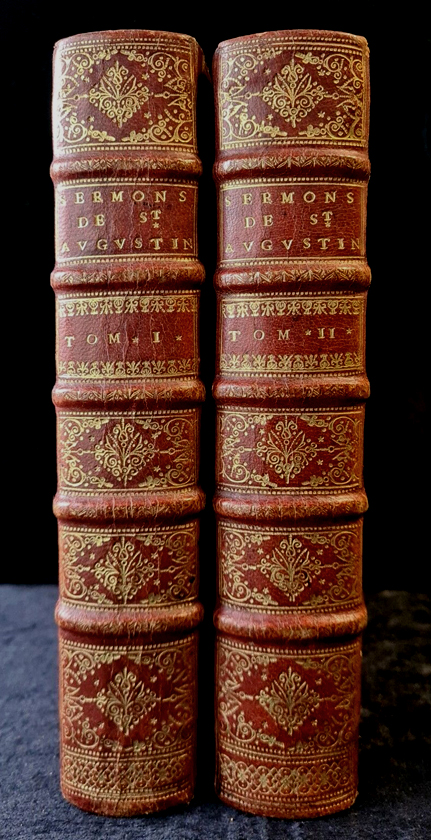
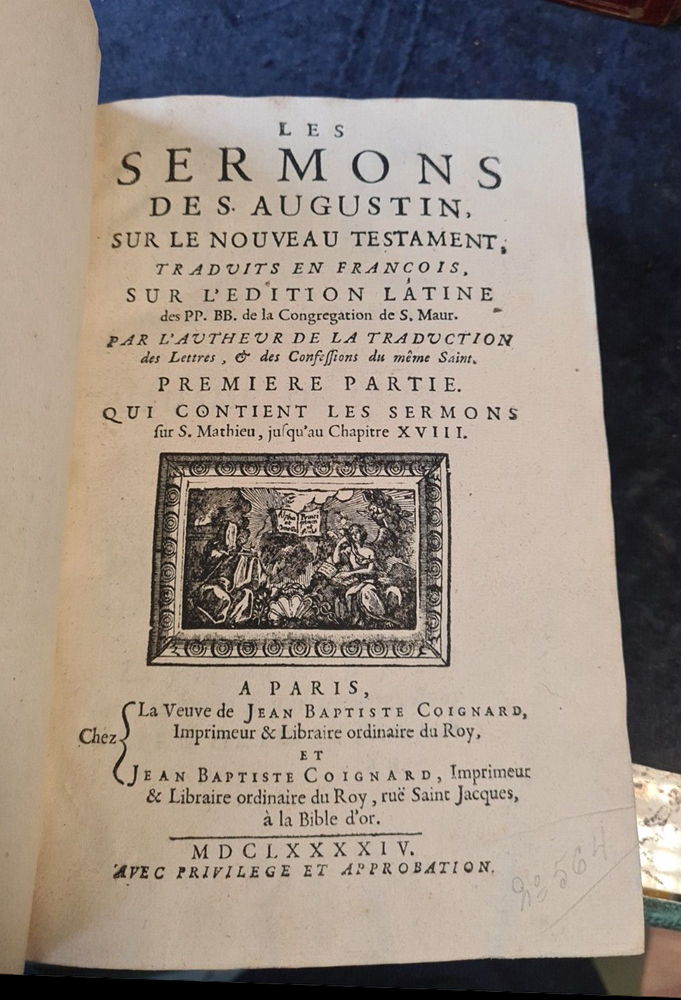
|
On this page we are going to look at a pair of classic Luc-Antoine Boyet bindings. These appeared on eBay last month (April 2023) and the seller's photos were excellent. This was obviously a Boyet, although one can never be absolutely certain. What a treasure! I knew I had to make a strong effort to capture this prize. What is a Boyet worth one might ask, considering this day and age where old baseball cards sell at auction for millions (see this). Here is a mystery… rare 18th century books, that are usually not really rare as there is a copy in every major library in the world, bring high prices at auctions while another not so rare 18th century book in an elaborately decorated binding, sells for peanuts. and yet the decorated binding, by a famous binder is by far more rare and is in fact a work of art, instead of something printed. Luc-Antoine Boyet was certainly one of the greatest bookbinders of his time, and worked for many prestigious clients as well as becoming the Royal binder for Louis XIV who was possibly the greatest French King that ever lived. You could not hope to get any higher than that in your profession. Boyet was the top of the top and his work was equal to the task, the quality of his bindings is legendary. His talents so great that his retrospective bindings fooled experts for centuries. So what then is a binding by Boyet worth? Personally I would say, worth more than mere money! One of the best publications available, that details the work of Boyet is: Reliures françaises du XVIIe siècle : chefs-d'oeuvre du Musée Condé : grands décors (1615-1665) et reliures pour les curieux (1690-1710) by Isabelle de Conihout, Pascal Ract-Madoux, Published in 2002. I show their binding example No. 30 below, with their description (see this). This binding, that was probably executed by Boyet around 1696 or a bit later, anyway in the period when he had just been officially made the Kings binder (relieur du roi). No. 30 is a retrospective binding however some of the imprints from the tools that he used to decorate the spine are also found on our 1694 eBay binding, that may have been bound in 1694 or perhaps a bit later. The pallet at the base of the spine is the same as well as the tool that was used to decorate the raised bands and probably the fillets are as well. |
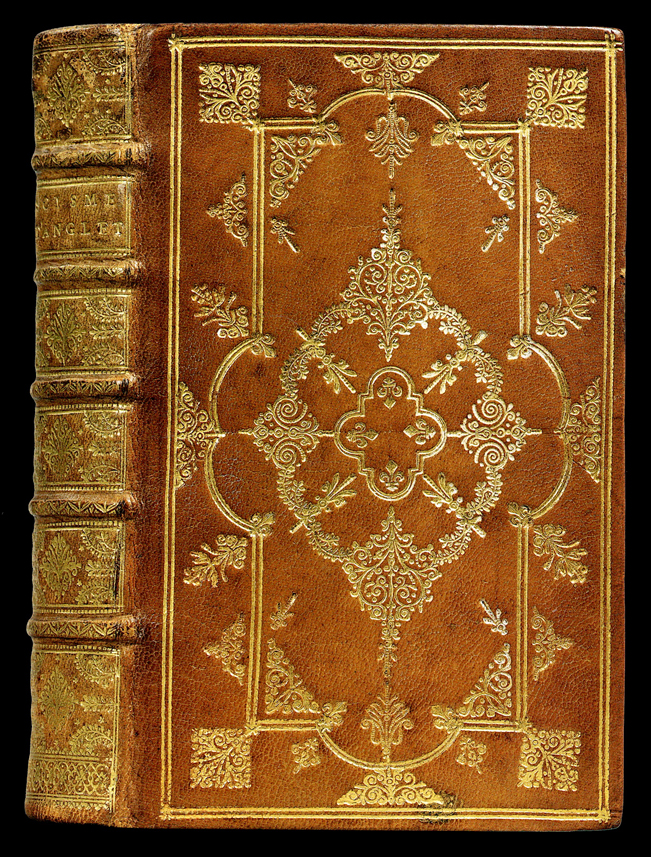
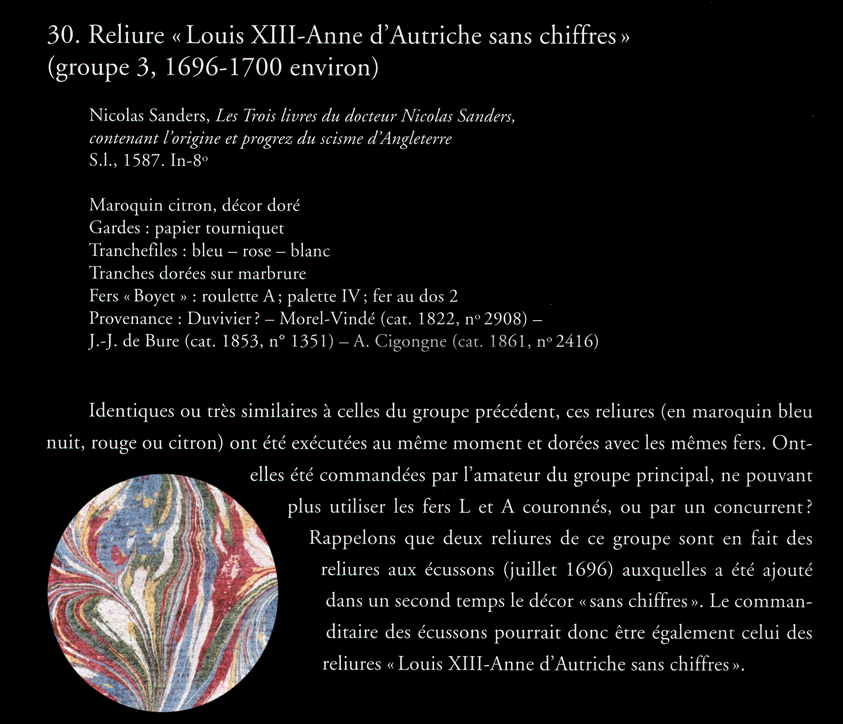
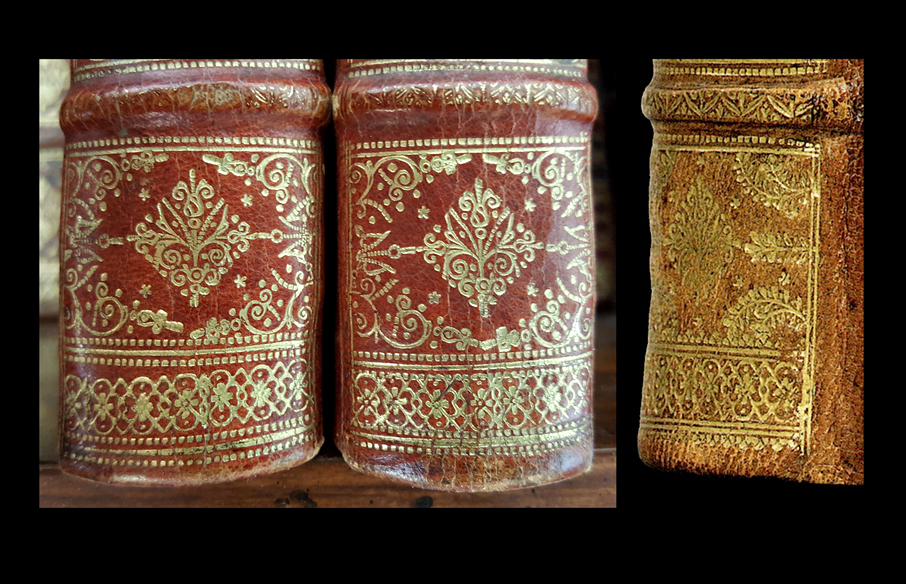
| In Comparative Diagram 1 we see that these pallets are the same however, the application of this pallet appears to have been a problem. Contrary to what one might expect I have shown the volume II spine on the side and Volume 1 in the middle and then the No. 30 spine. Now we can see that pallet IV appears to be cramped by the fillets as though the fillets had been laid down first leaving not enough room for the pallet. In the Volume II example this problem has been corrected however the bottom fillets appear to be out of alignment, and the pallet did not manage to rectify this. Another problem or failure is that this pallet may be rather short, necessitating that it is applied twice or more to cover the width of the spine. We see then that there is what appears to be an overlap in the application of the pallet in both examples. |
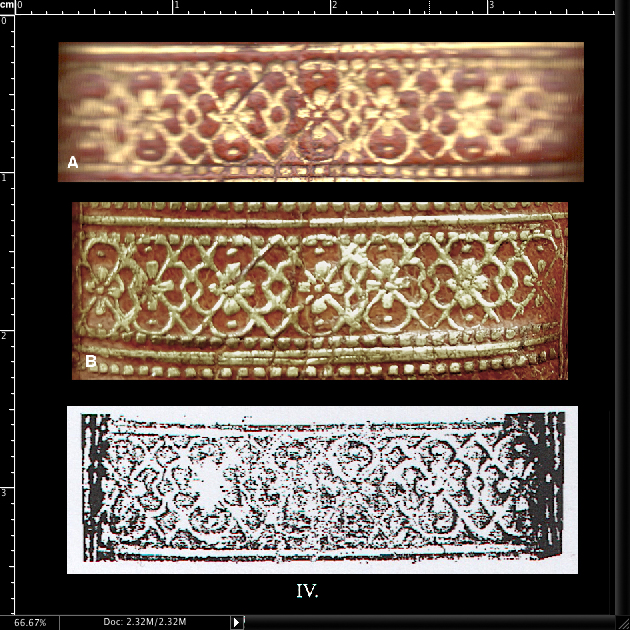
| In Comparative Diagram 2, we see first at the top a scan, that allows us to measure the exact height of the pallet. Under this a photo that is to a certain extent distorted by perspective, and at the bottom of the diagram we see the Conihout rubbing that serves as the type model of this pallet designated as IV. (see this) |
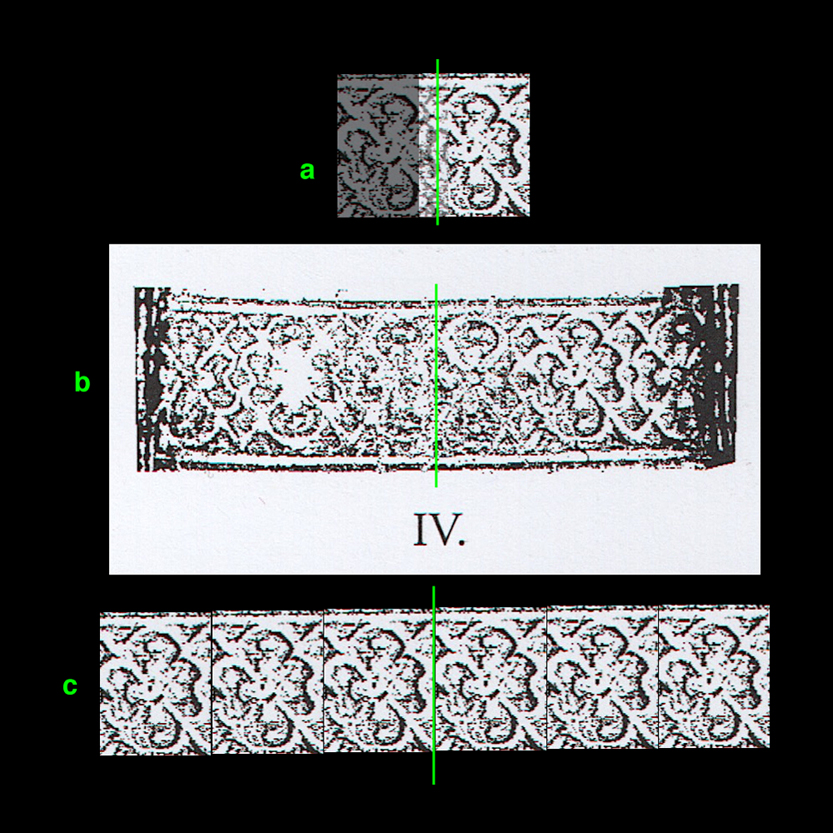
| In Comparative Diagram 3, 'c' is a rough assembly of six units that are repeated. In as much as the Conihout rubbing 'b' is not very clear, I wanted to try to understand how these elements fit together as well as where they overlap. When first looking at these pallet imprints nothing is very obvious in the jumble of parts. However in 'a' we see the solution, as the ends of the pallet overlaps. |

| In Comparative Diagram 4, we can see where the pallets overlap, and because the imprint of one pallet has been laid down lower than the next we observe clearly that this pallet comprises of 3 units. |
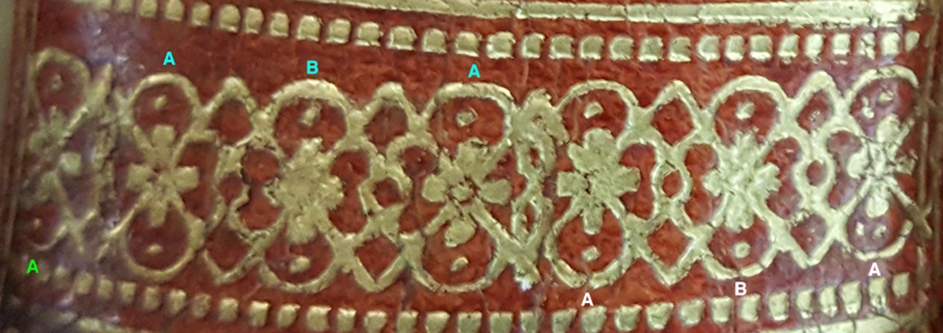
| In Comparative Diagram 5, I show a photograph of our 1694 pallet with units labeled. The central motif of the 'B' unit of the pallet is made up of multiple petals whereas the 'A' units are made of only four petals arranged horizontally and vertically. There seems to be no obvious reason why these pallet imprints are all found overlapping. |
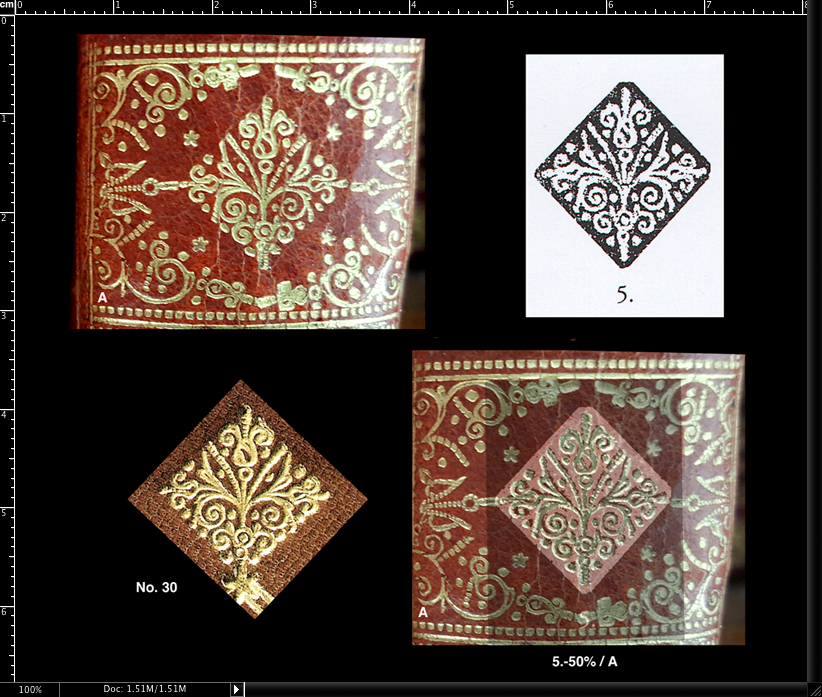
| In Comparative Diagram 6, I show a 1694 example of this fleuron from a spine panel, it matches the Connihout type model and the same fleuron is also seen decorating the strapwork corners of the boards of Boyet binding No.30. |
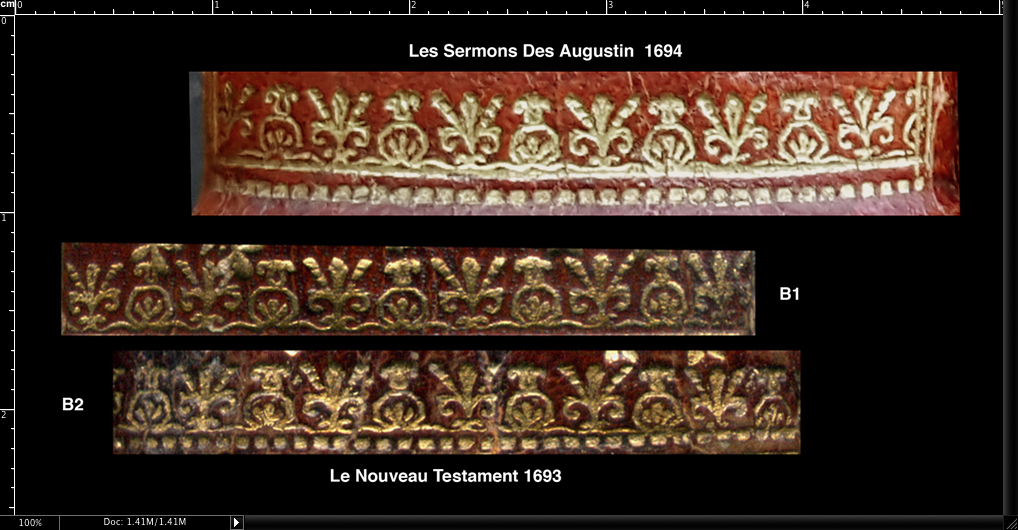
|
In Comparative Diagram 7, I present the solution to matching these strips of pallet VII-B without producing a roulette length i.e. the strips are not long enough to show the repeated motifs. This was a very long and tedious task that was also a bit distressing as for most of the exercise I did not find a matching sequence of anything. To understand this diagram you have to see my page on this There are two distinct types of this pallet that I outline as VII-A and VII-B, even armed with this knowledge it was still hard to find the alignment, and yet I am sure there will still be some who deny that they do align. On the next page we will look at a few more distinctive features of this 1694 Luc-Antoine binding, that for the most part looks and feels like new even though being more than 300 years old! |
|
click here to return to the HOME page. click here to see the INDEX of the 2017 pages. see below links to previous work |
| Even experts are sometimes wrong, before you spend thousands on a book, please do your own research! Just because I say a certain binding can be attributed to le Maitre isn't any kind of guarantee, don't take my word for it, go a step further and get your own proof. In these pages I have provided you with a way of doing just that. |
| Virtual Bookings, created by L. A. Miller | return to the Home page of VIRTUAL BOOKBINDINGS |